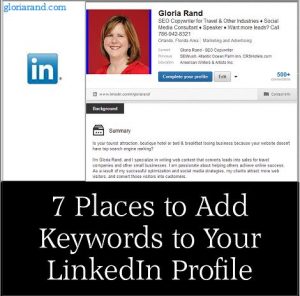 One of my first blog posts (and one of my most popular) was called, “6 Places to Add Keywords to Your LinkedIn Profile.” It was written back in 2010, and LinkedIn has certainly changed a great deal since then. At that time, there were 187 million professional members in 200 countries. Today, there are 277 million members. Of that number, 34 percent have incomes over $100,000. There were no company pages back in 2010 either, but today, there are more than three million of them.
One of my first blog posts (and one of my most popular) was called, “6 Places to Add Keywords to Your LinkedIn Profile.” It was written back in 2010, and LinkedIn has certainly changed a great deal since then. At that time, there were 187 million professional members in 200 countries. Today, there are 277 million members. Of that number, 34 percent have incomes over $100,000. There were no company pages back in 2010 either, but today, there are more than three million of them.
LinkedIn marketing expert Lewis Howes once said, “LinkedIn is the number one social networking site on the planet today. And… it’s the number one site for anyone looking to build their business.” I believe that’s certainly true today. I did some work for Scholastic Book Fairs a number of years ago. That job came about because the social media manager who was hiring found my profile on LinkedIn. I’m still getting leads from the site today.
There are many ways to use LinkedIn to get clients and find a job, but your prospects must be able to find you on the social networking site. Here are seven places that you must include keywords in your LinkedIn profile to enable it to show up in a search:
- Professional Headline – Located directly underneath your name, the headline is like an amped-up business card. If you don’t include keywords here, what’s the point?
- Current Occupation
- Past Occupation
- Websites – LinkedIn’s default choices are “My Website,” “My Company,” and “My Blog.” But when you edit your profile, choose “Other” and replace those headings with keywords that describe your website, company, blog, or another social networking site, like Facebook, for example.
- Summary – This is the area where you can advertise your services to your target market. In LinkedIn’s early days, users displayed their resume here. I still see this happening, unfortunately. Remember, LinkedIn is a social networking site. You wouldn’t go up to someone at a networking meeting and recite your resume to them, would you? Of course not! Instead, you would introduce yourself. Do the same thing here. The summary should be written in the first person, as if you’re speaking to someone, and it should include keywords that are relevant to your profession and industry. **LinkedIn no longer includes a section directly underneath the summary called “Specialties.” However, you can list keywords that represent your skills and specialties by typing that information into the summary box yourself.
- Skills/Endorsements – LinkedIn morphed specialties into the “Skills/Endorsements” area. This is an opportunity for you to display the skills you use in your profession. And it gives your colleagues and connections a chance to endorse you for those skills. This can get a little weird because your connections can also suggest skills that you may or may not actually have. If you’re just setting up this section, make sure you use the keywords that are most important and relevant to you, so they’ll show up in search AND be displayed prominently in this section, rather than down below as “Jane Doe also knows about…”
- Projects – Use keywords to describe any current and past projects that you would like prospects or potential employers to know about.



